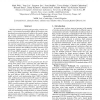Free Online Productivity Tools
i2Speak
i2Symbol
i2OCR
iTex2Img
iWeb2Print
iWeb2Shot
i2Type
iPdf2Split
iPdf2Merge
i2Bopomofo
i2Arabic
i2Style
i2Image
i2PDF
iLatex2Rtf
Sci2ools
MICRO
2008
IEEE
2008
IEEE
From SODA to scotch: The evolution of a wireless baseband processor
With the multitude of existing and upcoming wireless standards, it is becoming increasingly difficult for hardware-only baseband processing solutions to adapt to the rapidly changing wireless communication landscape. Software Defined Radio (SDR) promises to deliver a cost effective and flexible solution by implementing a wide variety of wireless protocols in software. In previous work, a fully programmable multicore architecture, SODA, was proposed that was able to meet the real-time requirements of 3G wireless protocols. SODA consists of one ARM control processor and four wide single instruction multiple data (SIMD) processing elements. Each processing element consists of a scalar and a wide 512bit 32-lane SIMD datapath. A commercial prototype based on the SODA architecture, Ardbeg (named after a brand of Scotch Whisky), has been developed. In this paper, we present the architectural evolution of going from a research design to a commercial prototype, including the goals, tradeoff...
Hardware | MICRO 2008 | SIMD | SIMD Datapath | Wide Simd Datapath |
| Added | 31 May 2010 |
| Updated | 31 May 2010 |
| Type | Conference |
| Year | 2008 |
| Where | MICRO |
| Authors | Mark Woh, Yuan Lin, Sangwon Seo, Scott A. Mahlke, Trevor N. Mudge, Chaitali Chakrabarti, Richard Bruce, Danny Kershaw, Alastair Reid, Mladen Wilder, Krisztián Flautner |
Comments (0)

